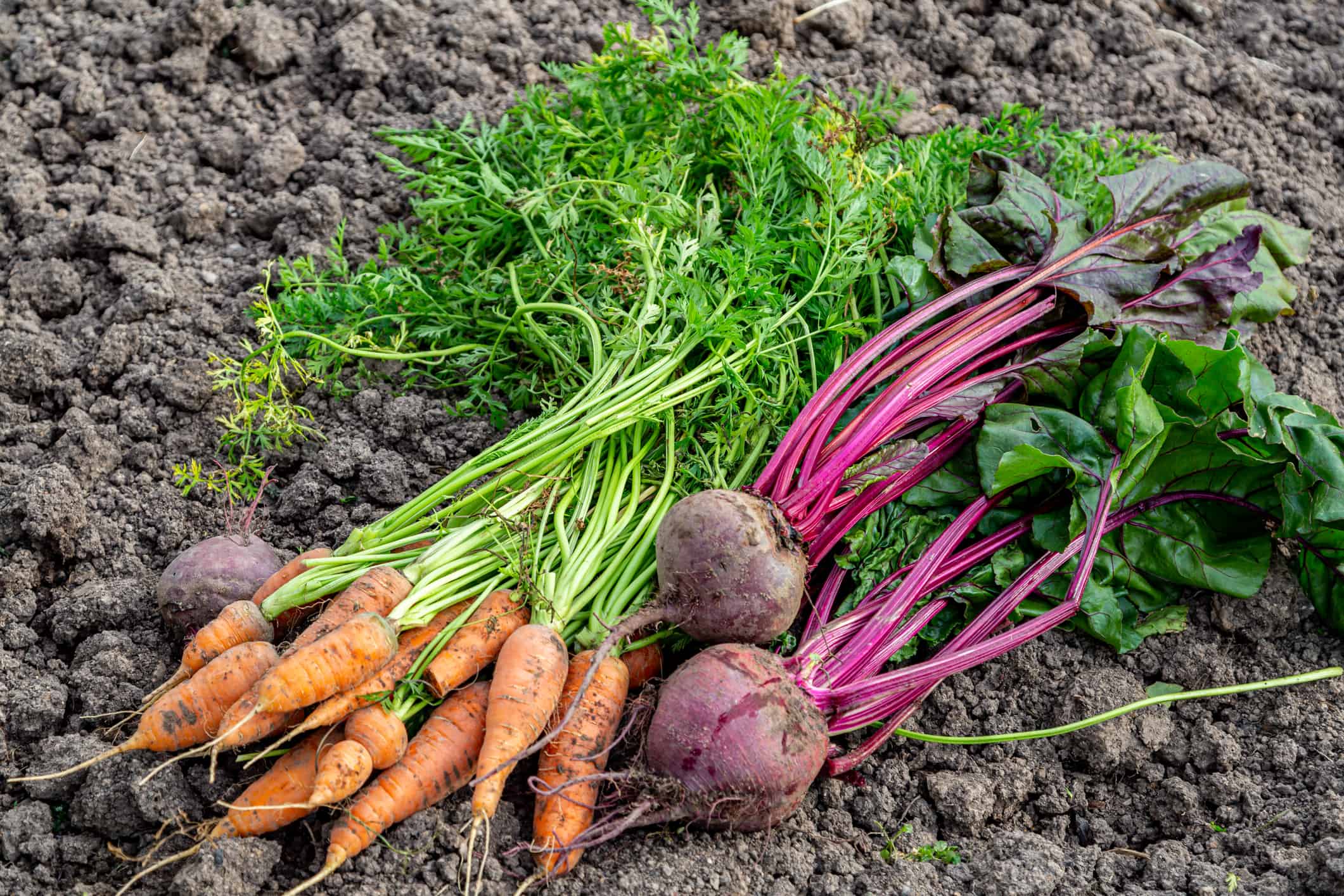As fall approaches, many gardeners are sad to see their hard work come to an end. But it doesn’t have to! Plenty of delicious crops can still get planted in August for a late summer or early winter harvest. However, that still may feel like it’s cutting the potential frost a bit too close for comfort. Thankfully, several root crops will survive a frost and may even survive hard freezes. Below we’ll look at seven root vegetables you can plant in August to keep your garden producing!
1. Carrots
Who doesn’t love carrots? Most people enjoy them in at least some form. The good news is that this vegetable is incredibly winter-hardy. You can leave them in the ground through a frost or a freeze and then harvest them when the ground thaws out enough. And since carrot seeds actually like some cooler weather for germinating, late August is the ideal time to sow them.
Find a spot with loose and fertile soil that gets full sun throughout most of the day. Take the time to break up any large clumps in the ground as you loosen them. This step will give your carrots a better shot at reaching their full size. You will want to space the seeds out roughly every two inches and then thin them once the seedlings reach two to three inches tall. Cover the seeds with a loose, light layer of soil and gently soak them.
Most carrot varieties will thrive in the cooler fall weather, so don’t be shy about trying some new shapes, sizes, or colors!
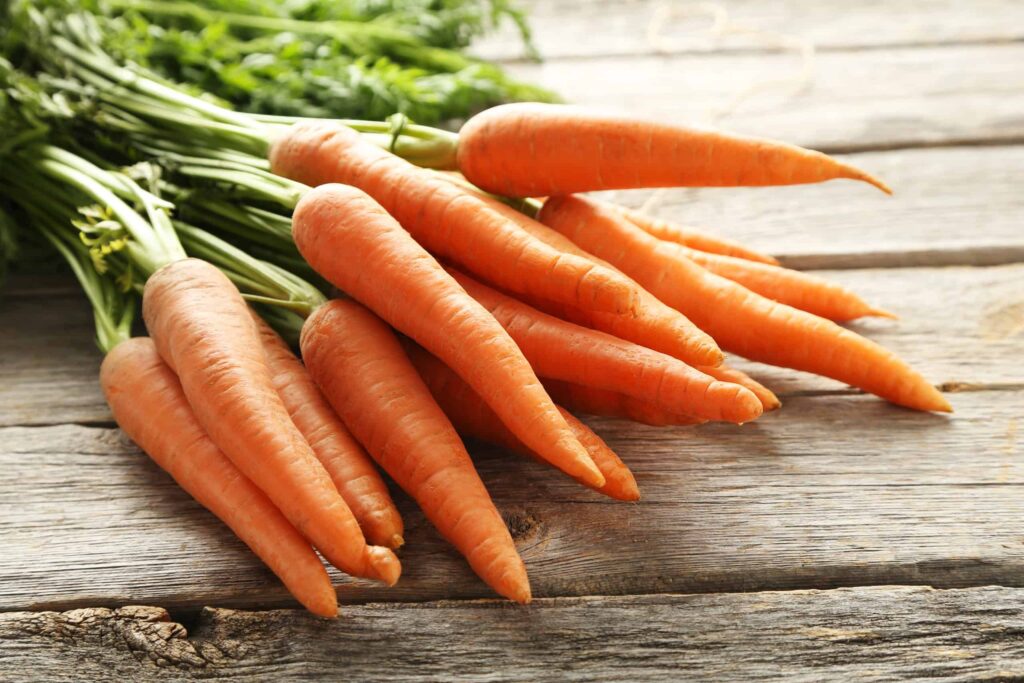
Carrots are one of the perfect vegetables to plant in August. They can handle a little frost and taste even better in cooler weather.
©5 second Studio/Shutterstock.com
2. Beets
If you haven’t started growing beets yet, you should consider planting some this August. Most of us are familiar with the deep red, almost purple-colored beets that are most common in produce sections. But there is an entire world of beets out there that won’t stain your hands! This root vegetable does well in colder temperatures that are near freezing. However, you will probably want to harvest your crop before the serious cold arrives.
You can successfully grow beets in nearly any kind of soil, though they do best in fertile ground. The primary thing they need is plenty of sunlight. Make sure you plant them in a location with at least six hours of direct sun daily. Plant your beet seeds roughly 2 inches apart. You can pre-soak them for 24 hours to help speed up the germination process, although they won’t take as long to sprout in summer.
While you’re waiting on the root to develop, consider harvesting a few of the delicious and tender beet greens for dinner. These highly nutritious greens are fantastic stir-fried or steamed. Just be sure to take only a few — the roots need the leaves to develop.
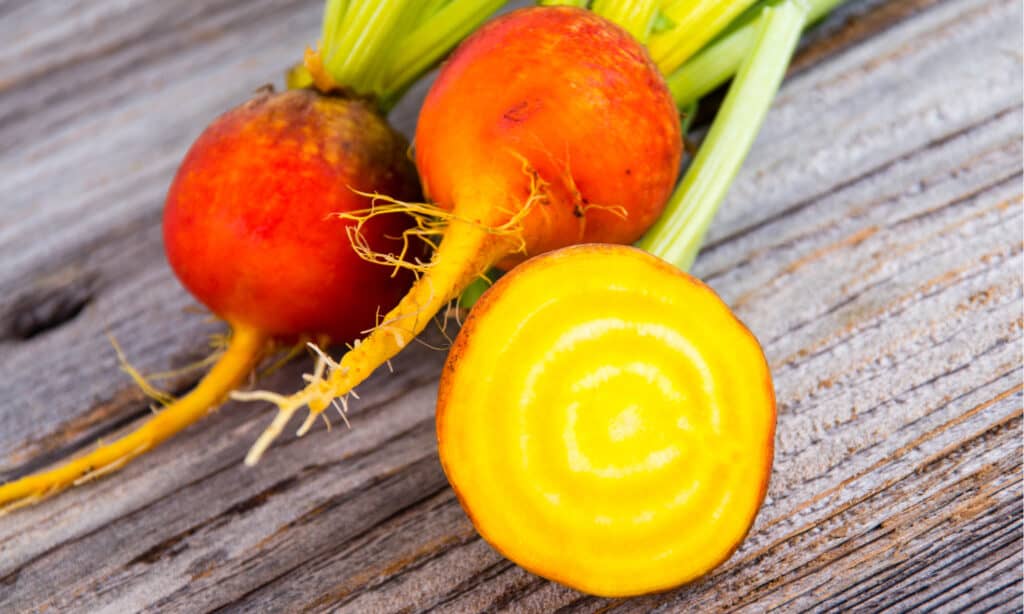
Beets do well in colder temperatures that are near freezing.
©julie deshaies/Shutterstock.com
3. Turnips
Consider diving turnip growing if you’re new to the unusual root vegetable. They are fast-growing and have a fantastic flavor (especially when harvested young). Don’t let the appearance, odd name, or picky eaters make you shy away from this veggie. Since they are fast-growing vegetables, they are perfect for planting in August.
Sow your turnip seeds about one inch apart, but do not plant them deeply. They only need approximately ¼ to ½ inch of soil above the seeds. Make sure to water thoroughly and frequently to encourage great root growth. You will want to thin the seedlings after they reach about four or five inches tall. And that’s about all the care they need. Turnips typically take 50-60 days to reach maturity. So many areas can get a fall harvest before the first frost, while others will enjoy the tender flavor achieved after a frost. Like beets, the greens are edible, so feel free to harvest some of those as well!
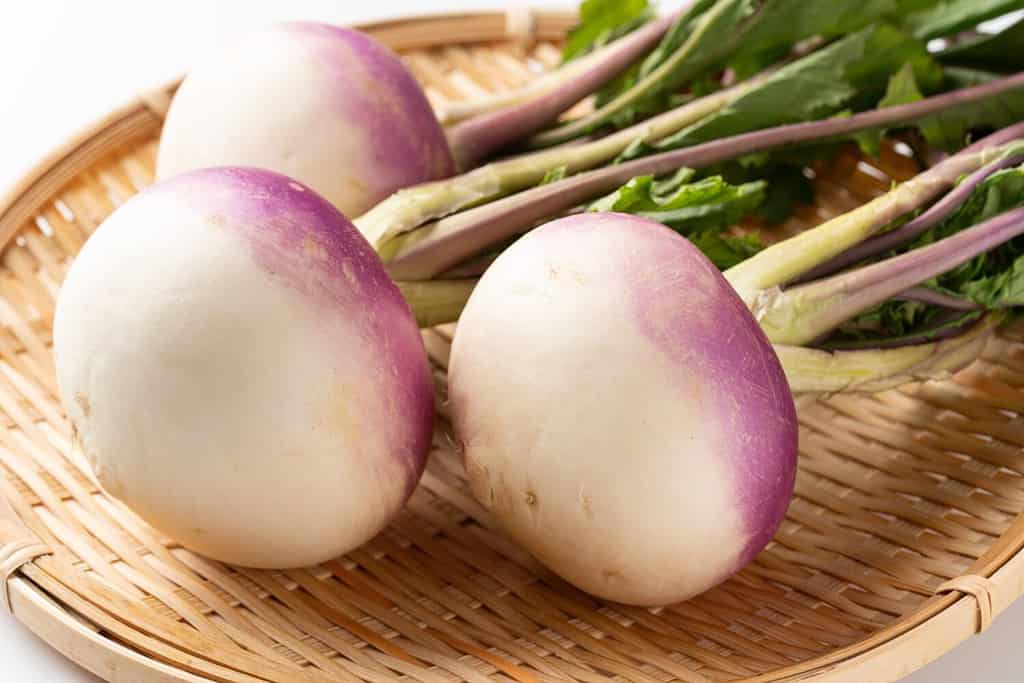
Turnips are fast-growing and have a fantastic flavor — especially when harvested young.
©Hanasaki/Shutterstock.com
4. Radish
Anyone who loves planting radishes knows that they have to give up the tiny root vegetable during the height of summer. They don’t like high heat. So your greens will grow, but the bulbs won’t typically develop. However, August is prime time for radish planting, so prepare your seeds. As nights start getting cooler, the radish bulbs will do much better. Plus, radishes are beginner-friendly and only take four to six weeks to reach maturity.
Before you sow your seeds, take a moment to loosen the soil. Doing so will help encourage better growth. Plant the radish seeds about ¼ inch deep, roughly one inch apart. Radishes don’t need much to thrive. Except they require consistent water, so thoroughly soak the planting area each time you water.
There are also a nearly endless number of radish varieties to grow, so don’t feel like you need to stick with the bright red ones from the store. You can also venture into black radishes or daikon radishes if you’re feeling adventurous.

Radishes are beginner-friendly and only take four to six weeks to reach maturity.
©Andrii Zastrozhnov/Shutterstock.com
5. Kohlrabi
Have you heard of kohlrabi? If you frequent farmer’s markets, the chances are good that you have at least seen one of these unusual root vegetables. Now may be a good time to try growing one yourself! They belong to the Brassica family, so their growing conditions and care may feel familiar.
You will want to plant the seeds about two inches apart and only ¼ to ½ inch deep. Try to keep the area free from weeds (the best you can) and provide consistent water. Then sit back, and wait for this delicious vegetable to grow. It is a fast-growing veggie, so you won’t have to wait long to try it out. Get prepared for a surprising taste delight. Kohlrabi has a tender, slightly sweet, slightly peppery flavor. Some varieties even taste a bit like apples.
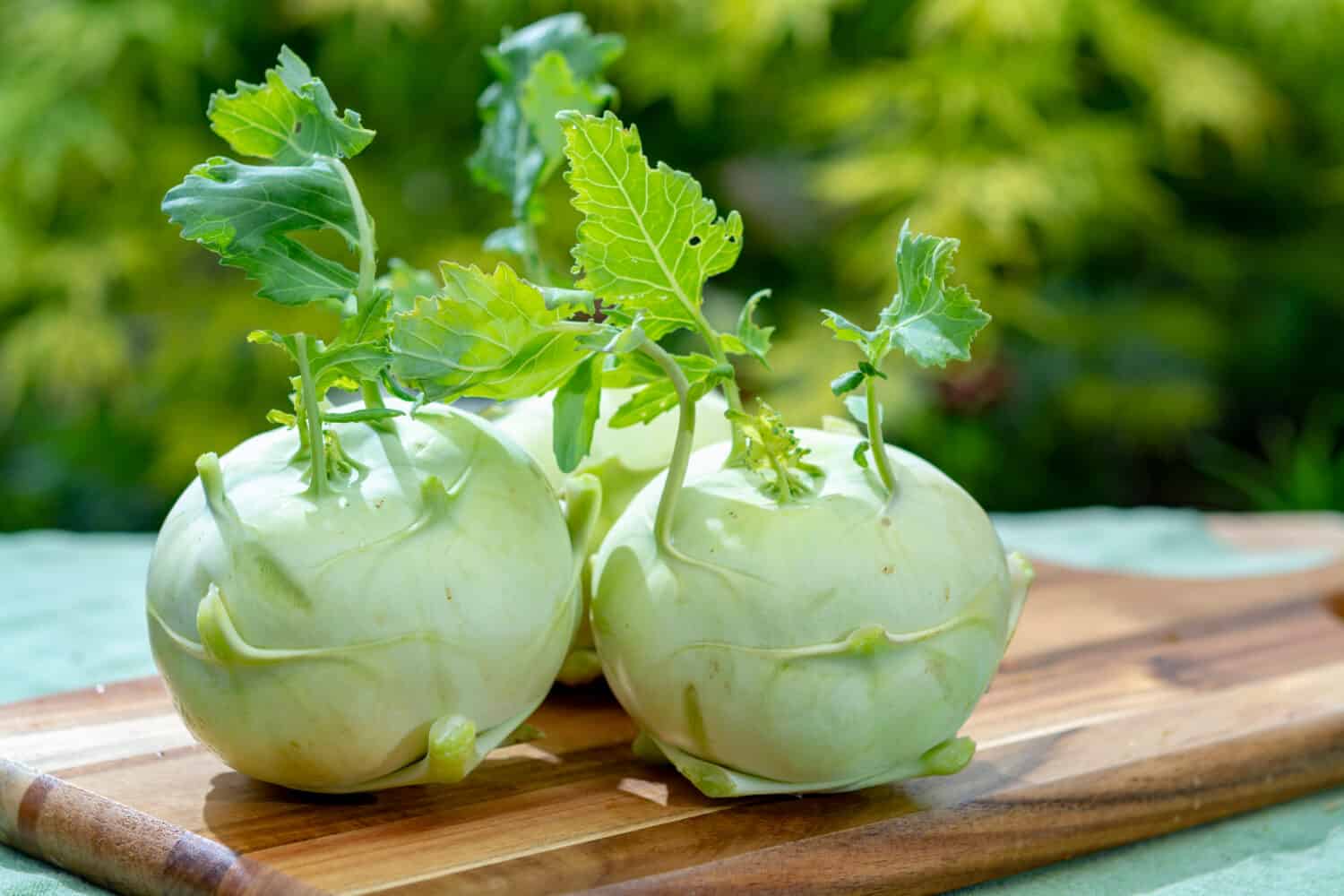
Kohlrabi has an almost other-worldly appearance.
©barmalini/Shutterstock.com
6. Potatoes
Potato lovers rejoice! You can still get one last round of potato planting in during August. That said, make sure to select the appropriate variety. Some of the longer season types won’t have enough time to develop. However, short season and new potatoes have ample time to finish growing before the freeze hits.
Find a spot with rich, loose soil that receives a minimum of six hours of sunlight daily. Compacted soil will stunt the tuber’s growth. Before planting your seed potatoes, dry them out for a few days. This process helps any cut parts of the seed potato develop a firm film to protect itself against rot. First, cut them into pieces, leaving an eye on each one. Then, lay them out in the warm sun.
After that protective layer develops, pop those potatoes in the ground (eyes up)! Keep them well-watered and protect them from any early frosts. Your potatoes are ready for harvest when the above-ground greens die off.
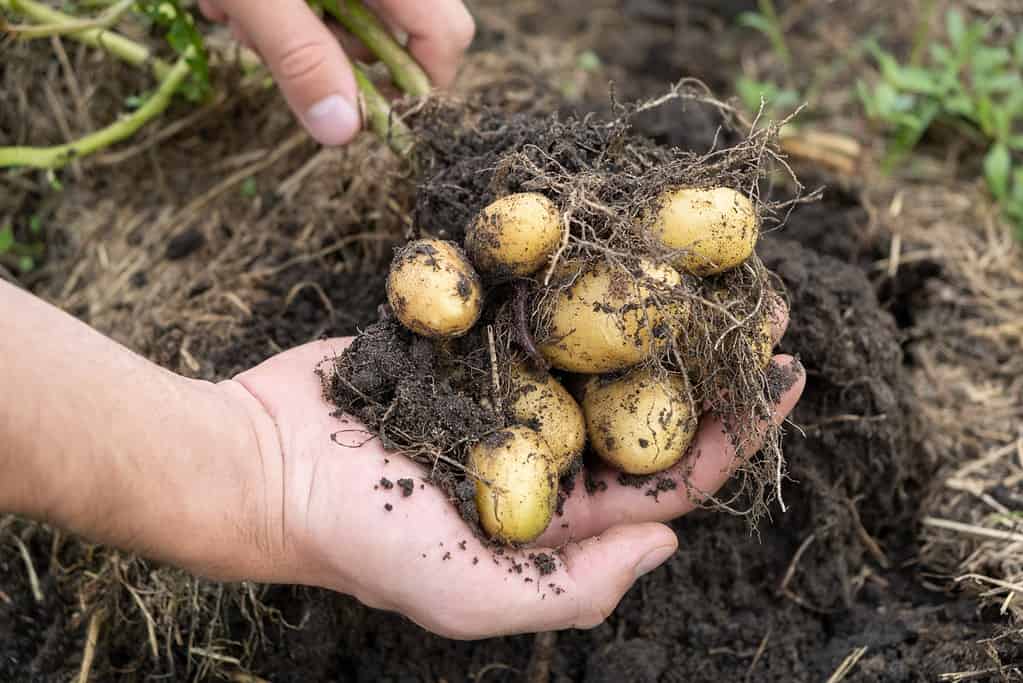
Potatoes grow surprisingly well in the fall, so feel free to plant those in August.
©ArieStudio/Shutterstock.com
7. Garlic
Unlike the other root vegetables on this list, you will not get the opportunity to enjoy your garlic this year. But plant it in August for two separate harvests next year! While the wait may feel a little long, don’t worry. You will get an abundant harvest out of it next year. It just means planning ahead.
Plant the garlic twice as deep as its size. So, for a 1-inch-long clove of garlic, add an inch of soil above it. Place it in the ground with the pointy part up. Your garlic will need a decent amount of water over the winter (which won’t be a problem in areas that receive snow). But the soil drains well since garlic doesn’t like getting waterlogged.
When spring arrives, harvest the edible scapes. And then your cloves will be ready the following August!
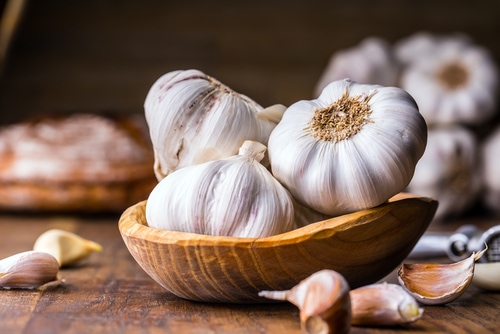
Unlike the other root vegetables, you will not enjoy your garlic this year, but you can plant it in August for two separate harvests next year!
©Marian Weyo/Shutterstock.com
| Number | Vegetable |
|---|---|
| 1 | Carrots |
| 2 | Beets |
| 3 | Turnips |
| 4 | Radish |
| 5 | Kohlrabi |
| 6 | Potatoes |
| 7 | Garlic |
Thank you for reading! Have some feedback for us? Contact the AZ Animals editorial team.

